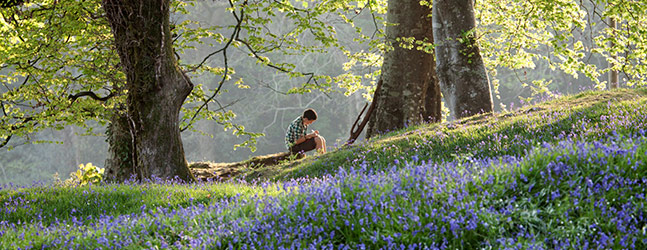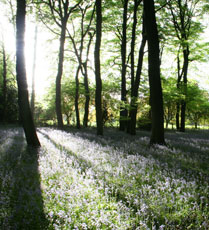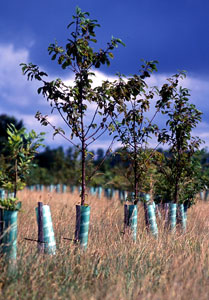



Waitrose is the first UK grocer to link the planting of trees in the UK to the activity of its home delivery vehicles. Every Waitrose.com delivery helps plant new trees. This is being done in partnership with the UK's leading woodland conservation charity the Woodland Trust.
Founded in 1972, the Woodland Trust owns more than 1,000 woods across the UK which are open to the public and free to visit. The Trust has more than 400,000 members and supporters.


Climate change is the greatest environmental challenge facing the world today – and carbon dioxide is a major contributor to the problem. Carbon dioxide (CO²) is produced principally from the burning of fossil fuels (coal, oil and gas) and increased deforestation. Trees capture and store atmospheric carbon and also bring many other more immediate benefits:
Sean Bean explains the importance of planting trees.

Spring is here and one of the sure signs it has arrived is the appearance of bluebells. To encourage people to get out and about exploring their woods, the Woodland Trust has compiled a list of the top ten woods to spot bluebells. And remember, you can find your nearest wood and the latest bluebell events at: www.woodlandtrust.org.uk/visiting-woods/bluebells

Hucking Estate; Maidstone, Kent
This 580 acre site in the Kent Downs Area of Outstanding Natural Beauty offers a mix of ancient woodland, planted secondary woodland and open grassland; together with woodland archaeology remains, wonderful walks, interesting wildlife and breath-taking views.
Priestley Wood; Needham Market, Suffolk
Considered to be one of the finest woods in Suffolk for its plant life. Notable trees include hornbeam and the rarest of all native trees, the wild pear. Plant life includes several species of orchid. Listen out for the song of the nightingale.
Bramingham Wood; Luton, Bedfordshire
An ancient woodland sanctuary in an urban environment. A network of paths, sometimes narrow and winding, leads to new discoveries, including ponds and several native fungi species found nowhere else in Britain. Stout footwear recommended.
Clanger & Picket Woods; Westbury, Wiltshire
Clanger, Picket and Round Woods have been designated a Site of Special Scientific Interest due to the varied butterfly and moth populations. Many paths lead off the main ride into cleared glades where bluebells thrive in spring. Well used by locals.
Hardwick Wood; Plymouth, Devon
This ancient woodland site is dominated by broadleaf trees. In spring, enjoy a superb show of bluebell, ransom and campion flowers. A network of green rides and narrow paths criss-cross the site, providing a variety of routes to explore.
Sea Wood; Ulverston, Cumbria
Visit both a wood and the seaside! Sea Wood stands against the northwest shore of Morecambe Bay and is edged by the shingle beach of Ulverston Sands. At one time large oak timbers from the site were floated at high tide to ship builders in Ulverston.
Masons Wood; Preston, Lancashire
Comprising mainly mature mixed broadleaf woodland and boasting rich ground flora. Eight main entrances and a network of linear surfaced footpaths link this site to the surrounding open space and public footpath network. Well used by local people.
Prehen Wood; Londonderry, Northern Ireland
This rare and irreplaceable ancient woodland has a magical feel, with carpets of bluebell, celandine and wood anemone in the spring. It is home to the red squirrel, sparrowhawk and long-eared owl and offers terrific views overlooking Derry/Londonderry city and the River Foyle.
Coed Bron Garth; Colwyn Bay, Wales
This ancient woodland is a carpet of bluebells in the spring and well worth a visit. Combine a walk with a visit the historic Llangystennin church or nearby Bryn Pydew Nature Reserve, or take a break from the National Cycle Network route from Penrhyn Bay to Llandudno Junction.
Urquhart Bay; Drumnadrochit, Scotland
On the banks of Loch Ness, Urquhart Bay is one of the best examples of surviving ancient wet woodland in Europe. Tree species include alder, ash, bird cherry and white willow. Footpaths form a rough figure of eight through the centre of the wood.

Our vision is a UK rich in woods and trees, enjoyed and valued by everyone. To achieve this and realise all the benefits woods and trees bring society, we aim to:
Create new woodland with schools, organisations and individuals and champion the need for a doubling of the UK’s native woodland cover by 2050.
Protect woodland, especially ancient woodland which is rare, unique and irreplaceable.
Restore damaged ancient woodland, bringing precious pieces of our natural history back to life.



Woodland Carbon removes carbon from the atmosphere through the creation of much needed native woodland across the country. It is a market-leading initiative that is designed to be both straightforward and flexible, and has won numerous awards.
The Woodland Trust is helping organisations just like Waitrose, that want to take positive action to limit the damaging impacts of their unavoidable carbon emissions. At the same time, companies will be supporting projects that improve biodiversity, enhance social wellbeing, help the landscape adapt to climate change and ensure that we will no longer be one of the least wooded countries in Europe.
Waitrose investment is enabling tree planting on Ministry of Defence land at the Warcop training area in Cumbria. So far the Waitrose partnership has helped to plant over 40 hectares of woodland and remove over 17,300 tonnes of C02. As well as removing carbon, the project also provides an important new habitat for conservation species such as the black grouse.